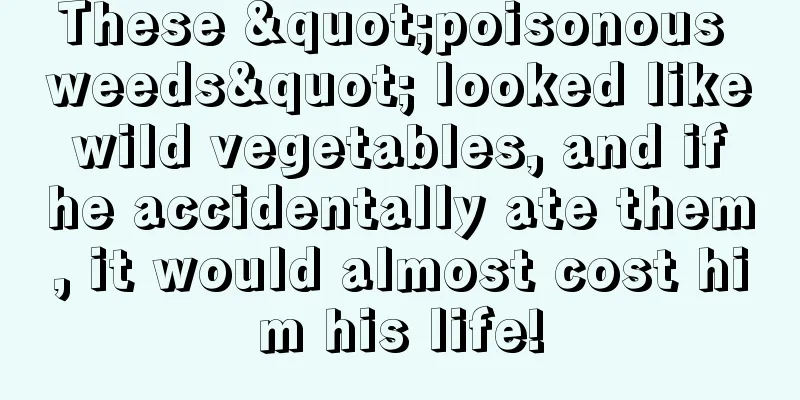These "poisonous weeds" looked like wild vegetables, and if he accidentally ate them, it would almost cost him his life!

Xanthium sibiricumDistribution: Grown in fields, roadsides and depressions. It sprouts in March and April, and the seedlings look like the vegetables we eat every day - bean sprouts. Toxicity: The whole plant is poisonous. Among them, young sprouts and seeds are the most toxic and can cause death if accidentally ingested. (Bean sprouts) Symptoms of poisoning:After poisoning, the patient will experience general weakness, dizziness, nausea and vomiting. Severe cases can cause respiratory failure and death. Poison HemlockDistribution: Grows in wet places, such as by the water or ditch in swamps. Toxicity: The leaves are like the celery leaves we often eat. The whole plant has a foul smell, and the flowers are the most toxic. (celery) Symptoms of poisoning:Symptoms include blisters on the lips, nausea, vomiting, followed by headache, general weakness, and loss of ability to move. (Poison Hemlock) ArisaemaDistribution: Grown under forests, thickets or grasslands. Its root is similar to ginseng. Toxicity: The whole plant is poisonous. Symptoms of poisoning:Chewing raw Arisaema can cause numbness, swelling and pain in the tongue, throat and oral cavity, and even slow breathing and suffocation. Husband SilverDistribution: Grown on hillsides, grasslands and roadsides. Also known as wild carrot and cnidium monnieri. Toxicity: Both leaves and roots are highly toxic. Symptoms of poisoning:Symptoms of poisoning are similar to those of poison hemlock, with subsequent ultraviolet sensitivity, and death from respiratory failure in large doses. Huahua reminds: These wild vegetables must not be touched! In addition to these types of vegetables that should not be touched, there is another type of vegetables - photosensitive wild vegetables. If people with photosensitivity eat them and then expose them to strong light, they will experience redness, swelling, and rashes on the exposed skin, accompanied by obvious itching, burning or stinging symptoms. Shepherd's PurseWild shepherd's purse can be seen everywhere in fields, roadsides, and courtyards. The whole plant of shepherd's purse can be used as medicine, and the stems and leaves can be eaten as vegetables. purslanePurslane is commonly found in fields and roadsides. The tender stems and leaves can be used as vegetables. Gray vegetableGray vegetable mainly grows in fields, on the edge of fields, on roadsides, in front of and behind houses, etc. The seedlings and tender stems and leaves of the vegetable are edible, delicious, tender and nutritious. The above three wild vegetables are relatively common photosensitive foods. For safety reasons, friends with photosensitive constitutions should avoid eating them as much as possible. Recently, news of people accidentally eating poisonous wild vegetables has become common. I hope all flower lovers will pay special attention to safety when going out for fun. Picking wild vegetables can add fun to your journey, but you must carefully identify the wild vegetables you pick to avoid adding unpleasantness to your journey. Today's little popular science on wild vegetables ends here. I hope Huahua’s popular science is helpful. If you think the article is good You can share it with your friends~ |
<<: The efficacy and function of palace lantern longevity flower
>>: Can Gardenia be soaked in water?
Recommend
When is the flowering period of Christmas cactus and what fertilizer is best to apply during the flowering period
1. When is the flowering period of Schlumbergera?...
How to fertilize lucky bamboo
1. Soil culture fertilization method When fertili...
How to judge the death of yew
1. How to judge You can first break off a branch ...
What is the reason for the dry leaves of gardenia
1. Strong sunlight Reason: If the gardenia is exp...
Planting methods and precautions for potted plum blossoms
Planting method Potted plum blossoms are mainly c...
When is the best time to repot Podocarpus? Season and method of repotting
Podocarpus repotting time 1. Whether it is a Podo...
What flowers are suitable for growing in Luliang? What are the city flowers and trees?
1. Climate characteristics of Luliang Luliang has...
How to cultivate ground lotus?
The ground orchid gives people a feeling of magni...
How to grow potted lilies? Cultivation methods and maintenance matters
How to grow lily in pots 1. Flower pot: When cari...
How deep should water lilies be planted?
Water lilies have a long history of cultivation i...
How and when to grow potatoes on the balcony How and when to grow potatoes on the balcony
It is good to grow potatoes on the balcony. The e...
Common diseases and their prevention in June
powdery mildew In June, many plants, such as heat...
What month is suitable for planting peach seedlings? When is the best time to plant them?
When to plant peach seedlings Peach seedlings are...
How to plant blueberry seedlings
1. Planting seedlings Generally, planting is chos...
Don't grow these 3 kinds of flowers. The leaves are poisonous and will cause swelling when touched by the skin.
Huahua discovered that plants like the familiar C...









